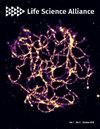Nr1h4 和 Thrb 可改善 ER 压力,并为 MPTP 帕金森病小鼠模型提供保护。
IF 3.3
2区 生物学
Q1 BIOLOGY
引用次数: 0
摘要
ER应激升高与包括神经变性在内的多种疾病的发病机制有关。在这项研究中,我们全面测定了所有核受体(NRs)在经典ER应激诱导剂存在时的差异表达。通过同源配体(GW4064 和 T3)激活 Nr1h4 和 Thrb,可改善妥尼霉素(TM)诱导的 ER 应激基因的表达。这两种配体的组合能有效减轻 TM 诱导的细胞死亡。对它们在帕金森病(PD)模型中保护作用的进一步探索表明,在体外帕金森病模型的神经细胞中,它们能减少 MPP+ 诱导的线粒体膜电位耗散和 ROS 生成。此外,实验性小鼠帕金森病模型的生成表明,在 MPTP 小鼠帕金森病模型中,GW4064 和 T3 的同时治疗可保护小鼠免受 ER 应激、多巴胺能细胞死亡和功能障碍的影响。因此,Nr1h4和Thrb各自配体的激活在ER应激改善和MPTP小鼠帕金森病模型的保护作用中起着不可或缺的作用。本文章由计算机程序翻译,如有差异,请以英文原文为准。
Nr1h4 and Thrb ameliorate ER stress and provide protection in the MPTP mouse model of Parkinson's.
Elevated ER stress has been linked to the pathogenesis of several disease conditions including neurodegeneration. In this study, we have holistically determined the differential expression of all the nuclear receptors (NRs) in the presence of classical ER stress inducers. Activation of Nr1h4 and Thrb by their cognate ligands (GW4064 and T3) ameliorates the tunicamycin (TM)-induced expression of ER stress genes. A combination of both ligands is effective in mitigating cell death induced by TM. Further exploration of their protective effects in the Parkinson's disease (PD) model shows that they reduce MPP+-induced dissipation of mitochondrial membrane potential and ROS generation in an in vitro PD model in neuronal cells. Furthermore, the generation of an experimental murine PD model reveals that simultaneous treatment of GW4064 and T3 protects mice from ER stress, dopaminergic cell death, and functional deficits in the MPTP mouse model of PD. Thus, activation of Nr1h4 and Thrb by their respective ligands plays an indispensable role in ER stress amelioration and mounts protective effects in the MPTP mouse model of PD.
求助全文
通过发布文献求助,成功后即可免费获取论文全文。
去求助
来源期刊

Life Science Alliance
Agricultural and Biological Sciences-Plant Science
CiteScore
5.80
自引率
2.30%
发文量
241
审稿时长
10 weeks
期刊介绍:
Life Science Alliance is a global, open-access, editorially independent, and peer-reviewed journal launched by an alliance of EMBO Press, Rockefeller University Press, and Cold Spring Harbor Laboratory Press. Life Science Alliance is committed to rapid, fair, and transparent publication of valuable research from across all areas in the life sciences.
 求助内容:
求助内容: 应助结果提醒方式:
应助结果提醒方式:


